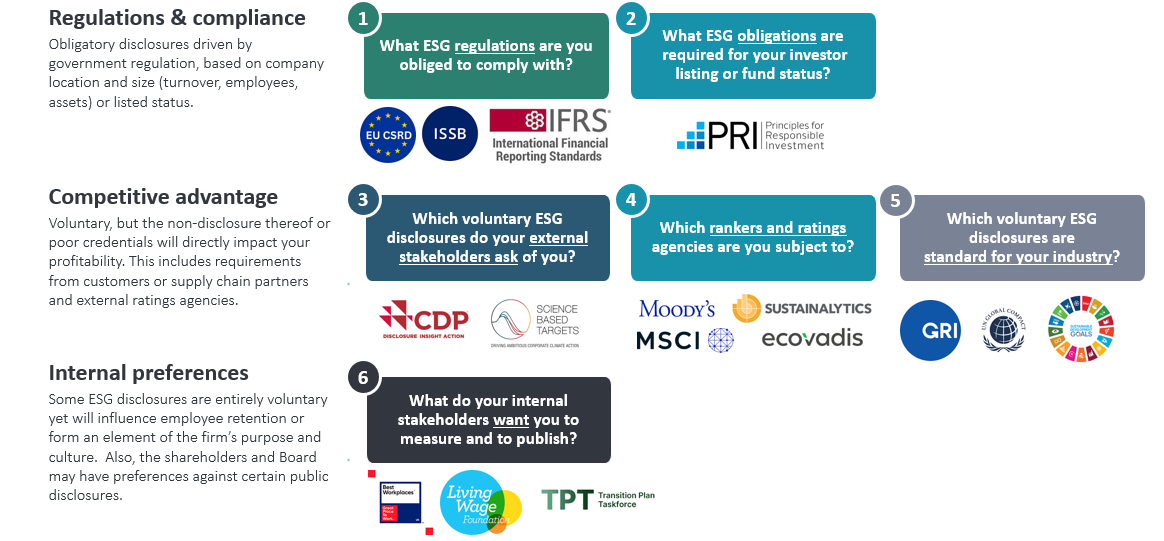Gain credibility for your commitments with disclosures and reporting and move from compliance to action and impact
Ace the “checkbox” and make ESG disclosures work for you

Why is it painful – yet important – to navigate the ESG disclosure “alphabet soup”?
We’d wager those who designed the content of ESG disclosures have never run a business. The huge quantity of data and narratives expected results in eye-rolling from most business professionals, and the accusation that ESG disclosures are just check boxes lands hard. Yet they can have business value when the disclosures are approached in the right way.
Rhizome strategy consultants ensure the exercise of completing ESG disclosures is value-adding to your organisation and that the reporting burden is minimised by using the interrelationships between the standards, frameworks and protocols.
It is important to recognise the different merits of the quantitative and qualitative ESG information. The former allows for trend analysis and peer comparison, the latter lets you add explanatory context to share your organisation’s approach and sustainability journey.
Transparency and accountability are foundational principles for sustainability to ensure authenticity and prevent greenwashing. Conducting inaugural ESG disclosures is time-consuming, but thereafter, if done well, it’ll be a straightforward process to update in an annual cycle aligned with your financial reporting timetable.
Disclosing your sustainability targets and performance publicly is the culmination of sustainability strategy creation and its implementation.
But completing these reports is a skill in itself, requiring a lead author who will both write the report and project manage the input from Legal, Finance, Operations, People, Marketing and senior leadership. The involvement of the Finance team is increasing in importance as they take on the responsibility for the reporting of non-financial data under the ISSB (International Sustainability Standards Board).
Rhizome strategy consultants provide accountability services in three areas:
An experienced counsel on the choice and prioritisation of ESG disclosures & reporting
We are experts at assisting organisations to weigh up what ESG reporting and disclosures are business critical and valuable versus those that are not (either to be parked to a future year or kicked into the long grass). Our ability to break down the disclosure requirements into sequential processes that are manageable and deliverable is very valuable to organisations.
Specialist provision of Climate Risk Analysis and Transition Planning
We offer specialist services in:
Climate-related Risks, Opportunities & Scenario Analysis (for IFRS S2 (TCFD), CDP and UK Climate-related Financial Disclosure)
Physical Climate Risk Assessment: Evaluating physical climate risks based on the exposure of particular assets to physical climate hazards to determine the vulnerability of the assets and provide adaptation and mitigation strategies.
Transition Climate Risk Assessment: Evaluating the risks to the business model resulting from the global transition to a lower carbon economy, developing risk mitigation strategies and integrating findings into financial models.
Transition Planning (using the Transition Plan Taskforce TPT framework)
Transition plans are required to be disclosed for IFRS S2 and are included in the CDP climate disclosures and are scored by EcoVadis. Rhizome strategy can work with you to create a transition plan summary for publication and a detailed transition plan for internal use.
An extra pair of qualified hands at critical times
We will work with your internal team with the reporting responsibility, bulking up resources and sharing our knowledge of how to complete ESG disclosures successfully, thereby providing both training and an extra pair of hands at time-critical moments. We can also provide project management skills to support the alignment of internal cross-functional staff to access data and manage the process to deliver the reporting on time.
What will drive your decisions to disclose and report?

Highlight:
Carbon & Climate
If you do just one thing …

“Climate first” is an acknowledgement by regulators that companies need direction and in 2025 the ISSB decided that companies can begin IFRS S1 reporting by disclosing only on climate-related information, with future sustainability topics to follow in subsequent years.
This requires carbon reporting; best practice follows these steps….
(1) Calculate Scope 1, 2 & 3 emissions using the GHG protocol
Carbon accounting is complex and creating a GHG emissions inventory to a level of assurance (limited or reasonable) from an independent auditor requires comprehensive data collection and internal controls. To get to this level of competency needs more effort than most firms realise.
(2) Commit to Science-Based carbon reduction targets.
The gold standard is the SBTi. The process to getting SBTi agreed near term and net zero targets requires a ton of paperwork and can take >6 months to execute.
(3) Write a Transition Plan
This will detail your company’s ambition actions and accountability for decarbonisation.
(4) Publish and action
Your commitments will be public and every year you will report on your progress towards achieving them.
….and evidence of climate change risk mitigation and adaptation by conducting IFRS S2 aligned climate-risk scenario analysis.
Highlight:
Materiality Assessments
What it is, why do it and how to approach it

A fundamental concept in sustainability is materiality. Taken from accounting, a matter is material if it could substantially affect the organisation’s ability to create value in the short, medium or long term. The logic is sound, as to have a true impact, firms should focus on sustainability topics that are material to them.
Fortunately, the SASB standards have already identified material topics by industry e.g., hotels should target energy & water management, ecological impacts, labour practices and have an adaptation plan for climate change risk. This makes sense, but the SASB standard for professional services makes less sense. Where is climate change? It is missing because SASB was developed to highlight financial risks from ESG impacts on a business.
The solution has been for standard setters to introduce Double Materiality a concept designed for organisations to identify material factors that might create financial risks AND the organisation’s own impacts on people and the environment.
To answer these questions, reporting guidance suggests organisations should widely consult all stakeholders on what they consider material. This makes for a big and expensive exercise, yet much can be done with desk research and common sense.
Contact us to discuss pragmatic and cost-effective ways of conducting materiality assessments that are business useful.

